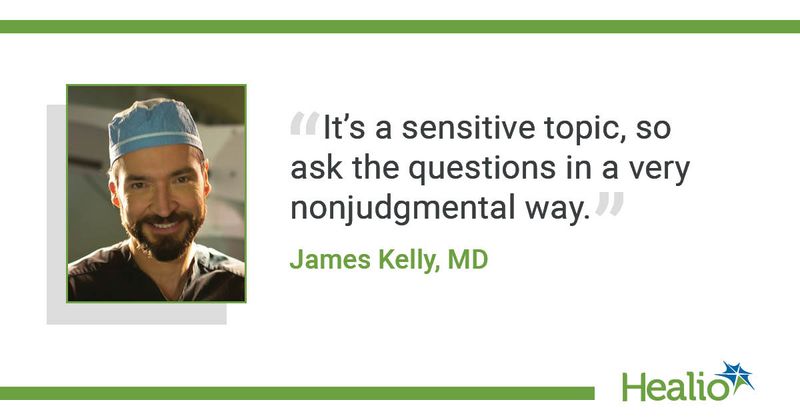Q&A: Good history, open conversations essential for ECPs to help stop STD spread
April is STD Awareness Month, and according to a statement from the U.S. Department of Health and Human Services, STD cases remain high among all demographic groups.
More than 2.5 million cases of syphilis, gonorrhea and chlamydia have been reported in the U.S., with concern growing around the syphilis and congenital syphilis epidemics.

Healio spoke with James Kelly, MD, attending physician at the Manhattan Eye, Ear, and Throat Hospital at Northwell Health, about STDs and how eye care providers can work together to reduce incidence and transmission.
Healio: What should clinicians be aware of in terms of how STDs can manifest in the eyes?
Kelly: One of the things I generally like people to know is that that STDs are on the rise, although it’s unclear why. This is something that all specialties in medicine are seeing. The best way to for an optometrist or ophthalmologist to be aware of them is to take a good history. A lot of times we can arrive at a diagnosis before we even examine the patient by just taking a good history and having a healthy level of suspicion.
Ask questions that would be appropriate for a given presentation of a patient. Get detailed information from them. When one is suspicious of an STD, there can be shame and judgment involved on both the part of the doctor and the patient. It’s a sensitive topic, so ask the questions in a very nonjudgmental way. I think it’s important to say, “We know that these sexually transmitted diseases can affect any part of the body, and the eye is no exception.” That’s critical for both doctors and patients to know.
Healio: How can clinicians maximize their chances of detecting STDs early?
Kelly: Again, it gets back to taking a good history and having it on your radar. With the major STDs — gonorrhea, chlamydia, syphilis, herpes, HPV and even HIV — that are so common, think about how a person might present. Look for signs and symptoms, including ocular discharge, redness, pain and light sensitivity.
Many diseases present with these nonspecific findings, but if you have a sexually active adult come in, ask them: Do you have any of these diseases? Are you sexually active with someone who may have any of those diseases? That maximizes the chances of early detection.
Healio: What are common misconceptions about STDs and how they affect the eye?
Kelly: One is that they don’t affect the eye when they absolutely can. With STDs, they basically are transmitted through body fluid exchange, so if one person’s body fluid is being exchanged with another person’s, they can contract it. The eye is a reservoir of body fluids. Understand that the eye, like the genitals, is comprised of a mucous membrane with fluid in it, making it an organ for STDs to be transmitted.
Healio: What should ECPs do when patients present with STD symptoms?
Kelly: Optometrists and ophthalmologists both have a role in the treatment of STDs. If the ECP has a high level of suspicion that a patient has an STD, lab testing and culturing should be performed. If a particular ECP does not have access to lab testing, comanagement with one who does would be beneficial. Often we refer the patient to an internist or general practitioner for further treatment if other parts of the body are affected. Early diagnosis, early treatment and early referral, if necessary, is the best way to manage patients who have suspected or confirmed STDs.
Healio: How can clinicians help prevent further transmission of STDs?
Kelly: Be clear with the patient: “You have this STD and you can transmit it to someone else.” Explain how it’s contagious and that they should notify their sexual partners, who also should get tested to prevent further spread. It’s a form of contact tracing, like we did with COVID.
Healio: How can clinicians introduce conversations about sexual health into their practices?
Kelly: Be open about the fact that STDs affect the eye. Let patients know you’re not judging them, and it's just something that can happen in the course of having intimate relations with another person. One of the things I tell my patients when I suspect they have an STD is, “Talk to your partners and tell them that we encourage them to get tested too, because, if we can get an early diagnosis and early treatment, we can prevent long-term complications, which may sometimes include vision loss.” We can stop the spread through early treatment and sharing knowledge.
Reference:
- Statement from HHS Assistant Secretary for Health ADM Rachel Levine for STI Awareness Week. https://www.hhs.gov/about/news/2024/04/12/statement-from-hhs-assistant-secretary-for-health-adm-rachel-levine-for-sti-awareness-week-april-14-20-2024.html. Published April 12, 2024. Accessed April 19, 2024.
For more information:
James Kelly, MD, is the founder of KellyVision, which has practices in New York City and the tri state area. He can be reached at @kellyvision.ny on Instagram, @kellyvisioncenter on TikTok, KellyLaserCenter on Facebook and @kellyvision on X.
